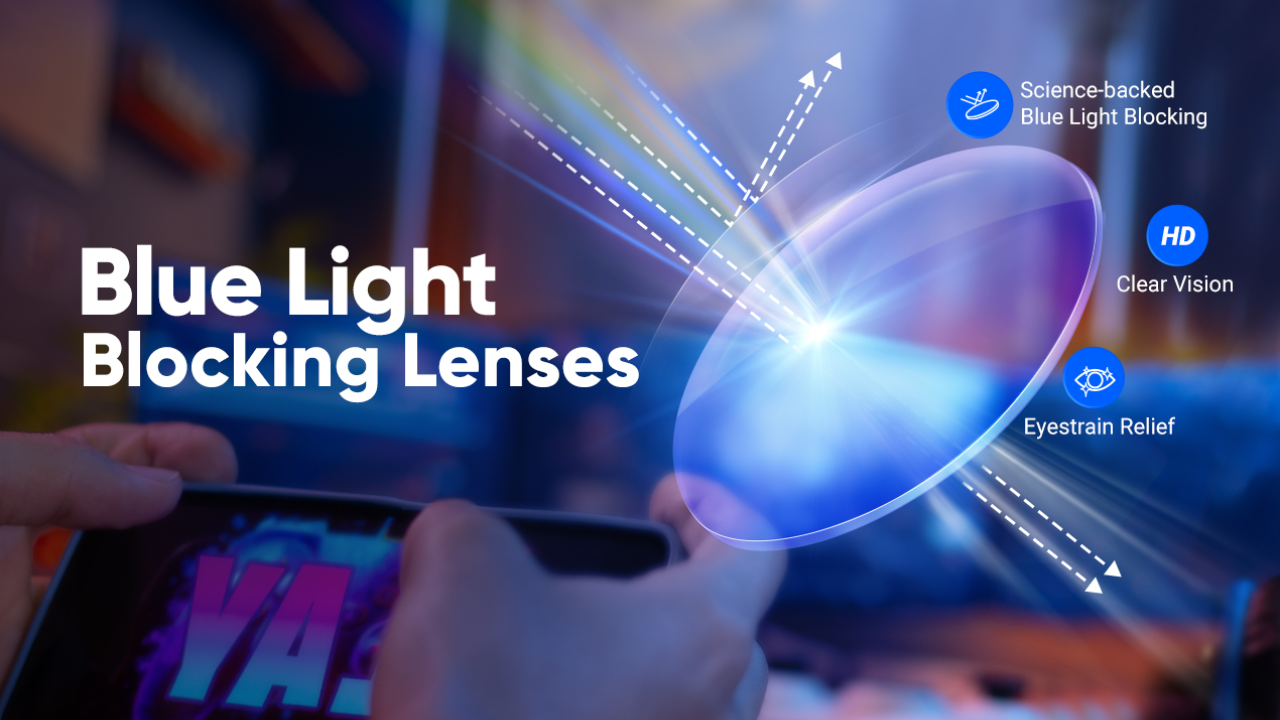
In today’s digital-driven world, our eyes are constantly exposed to screens—from smartphones and laptops to televisions and tablets. While these devices make life easier, they also emit blue light, a high-energy visible (HEV) light that has raised concerns among health experts. Understanding what blue light is, why it matters, and how to protect your eyes can make a huge difference in long-term eye health and overall well-being.
What is Blue Light?
Blue light is part of the visible light spectrum and is naturally present in sunlight. However, with the rise of digital devices, artificial exposure has skyrocketed. Unlike other light wavelengths, blue light penetrates deeply into the eye and can affect both vision and sleep cycles.
Main Sources of Blue Light:
- Sunlight (natural source)
- LED screens (phones, laptops, tablets, TVs)
- Fluorescent and LED lighting
- Gaming devices and smart screens
Why Blue Light Matters
1. Eye Strain and Digital Fatigue
Prolonged exposure to screens can cause digital eye strain, leading to dryness, headaches, and blurred vision.
2. Impact on Sleep Cycles
Blue light suppresses melatonin production, disrupting the body’s natural circadian rhythm. Late-night scrolling can delay sleep and reduce its quality.
3. Potential Long-Term Eye Risks
Some studies suggest that chronic exposure to blue light may contribute to retinal stress, increasing the risk of conditions like macular degeneration.
4. Children Are More Vulnerable
Kids spend hours on digital devices for both school and entertainment. Their developing eyes absorb more blue light, putting them at higher risk for eye strain and disrupted sleep.
How to Protect Your Eyes from Blue Light
1. Follow the 20-20-20 Rule
Every 20 minutes, look at something 20 feet away for 20 seconds to relax your eyes.
2. Use Blue Light Filters and Glasses
Many devices have “night mode” or blue light filters. Blue light-blocking glasses are also effective for reducing strain.
3. Limit Screen Time Before Bed
Avoid devices at least 1–2 hours before sleeping to improve melatonin levels and sleep quality.
4. Adjust Lighting and Screen Brightness
Work in well-lit environments and keep screen brightness aligned with room lighting.
5. Blink More Often and Stay Hydrated
Staring at screens reduces blinking, leading to dryness. Conscious blinking and hydration help maintain eye comfort.
6. Schedule Regular Eye Checkups
Eye professionals can detect early signs of strain and recommend personalized solutions.
Table: Effects of Blue Light on Health
| Impact Area | How Blue Light Affects You | Result You’ll Notice |
|---|---|---|
| Eye Strain | Long screen time stresses eyes | Dryness, headaches, blurred vision |
| Sleep Quality | Suppresses melatonin | Trouble falling asleep, insomnia |
| Productivity | Increases fatigue | Reduced focus and efficiency |
| Children’s Health | Eyes absorb more blue light | Tiredness, lack of focus, poor rest |
| Long-Term Vision | Potential retinal damage | Higher risk of vision problems |
Practical Eye Protection Tips
- Use anti-glare screens for laptops and tablets.
- Enable night shift mode on smartphones.
- Create a tech-free bedtime routine.
- Take outdoor breaks to give your eyes exposure to natural light.
- Invest in ergonomic setups to keep screens at eye level.
Overview Table
| Strategy | Why It Helps | Best Practice |
|---|---|---|
| 20-20-20 Rule | Relieves eye strain | Practice every 20 minutes |
| Blue Light Glasses | Blocks harmful wavelengths | Use during long work/screen sessions |
| Limiting Screen Before Bed | Supports healthy sleep cycle | Avoid screens 1–2 hrs before sleep |
| Adjust Screen Settings | Reduces intensity on eyes | Use night mode or lower brightness |
| Regular Eye Exams | Detects early issues | Annual checkups for all age groups |
| Hydration & Blinking | Keeps eyes moist and healthy | Drink water and blink consciously |
Final Thoughts
Blue light is not inherently bad—it’s a natural part of life. The problem lies in overexposure from digital devices. By practicing simple strategies like the 20-20-20 rule, using filters, and creating healthy digital habits, you can protect your eyes and maintain long-term vision health.
With screens becoming unavoidable, being mindful of blue light exposure is no longer optional—it’s essential for both adults and children to stay healthy, sleep better, and work more efficiently.
3 Quick FAQs
Q1. Is blue light harmful during the day?
Not necessarily—daytime blue light helps keep you alert, but excessive exposure can cause strain.
Q2. Do blue light glasses really work?
Yes, they reduce glare and filter harmful wavelengths, easing eye strain.
Q3. Can kids use blue light filters too?
Absolutely—blue light protection is especially important for children’s developing eyes.

